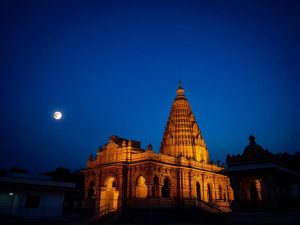The Rann of Kutch is sometimes loved for its white desert, colorful culture, and colorful Rann Utsav. But behind the music, dance, and adventure, there’s a spiritually deep Kutch too. Dispersed across its desert are ancient temples that beckon pilgrims and travelers alike. Going through these shrines not only brings you closer to faith but also unfolds stories and legends behind Kutch’s heritage.
Following are some of the most noted temples in the vicinity of Rann of Kutch.
1. Mata no Madh – Ashapura Mata Temple

Situated around 100 km from Bhuj, this temple is for Ashapura Mata, the guardian deity of Kutch. She is considered the goddess of wishes, and the temple is a prominent place of pilgrimage, with thousands of devotees visiting here during Navratri in particular. The history of the temple dates back to the Jadeja rulers of Kutch, who made Ashapura Mata their Kuldevi (family deity).
Why Go? For the festive mood, spirituality, and to see one of the most significant temples of Gujarat.
2. Desh Devi Maa Ashapura Temple, Khavda
Along the route to Dhordo (site of Rann Utsav), is a lesser yet just as sacred temple of Ashapura Mata in the village of Khavda. It is frequently traveled through by tourists bound for the White Desert. Ringed by local arts and mud huts, this temple provides a rural spiritual experience.
Why Visit? A brief detour for blessings prior to entering the White Desert.
3. Narayan Sarovar Temple
Situated at Kutch’s westernmost tip, Narayan Sarovar is regarded as one of the five holy lakes (Panch-Sarovar) of Hinduism. The temple group belongs to Lord Vishnu and has temples of Lakshmi, Trikamray, and other gods. People also come here as pilgrims for religious significance and peaceful locations.
Why Visit? To find spirituality at one of India’s westernmost pilgrimage centers.
4. Koteshwar Mahadev Temple
Only a few kilometers from Narayan Sarovar is Koteshwar Mahadev, a temple of Lord Shiva. Situated on the sea’s edge, it gives fantastic views of the sun setting over the Arabian Sea. Legend says that Ravana was presented a Shivling by Lord Shiva, and Koteshwar is the spot associated with the legend.
Why Visit? For mythological history and unparalleled sunsets.
5. Shree Swaminarayan Mandir, Bhuj
In the city of Bhuj is the Swaminarayan Mandir, which was rebuilt after the earthquake in 2001. Constructed of pure marble and detailed carvings, the temple is an architectural wonder as well as a sanctuary. It’s a must-see for tourists embarking on their Kutch adventure from Bhuj.
Why Visit? For its grandeur architecture, tranquility, and spiritual ambiance.
Final Word: A Fusion of Faith and Desert Beauty
The Rann of Kutch trip is not all about White Desert and cultural extravaganza. A visit to such temples imparts a spiritual theme to the experience where tourists get to feel the sacred bond between religion, history, and the land of Kutch.







